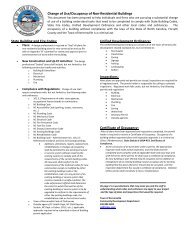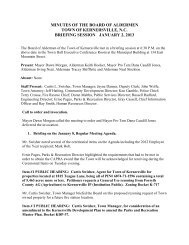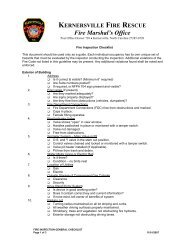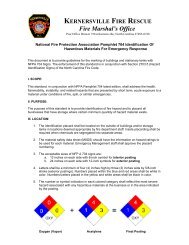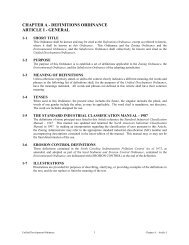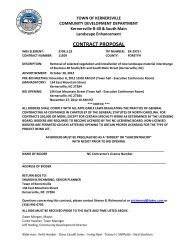Piedmont Greenway Master Plan - Town of Kernersville
Piedmont Greenway Master Plan - Town of Kernersville
Piedmont Greenway Master Plan - Town of Kernersville
- No tags were found...
Create successful ePaper yourself
Turn your PDF publications into a flip-book with our unique Google optimized e-Paper software.
sensitive to erosion and need to be protected. Moore’s Creek has soils that are derived from the Madison-Cecil<br />
association and can be characterized as strongly sloping to steep, well-drained soils that have a sandy clay<br />
loam, clay loam and clay subsoil. These soils are formed mainly on uplands <strong>of</strong> the creek’s watershed. Beaver<br />
Creek in Guilford County has soils composed <strong>of</strong> the Cecil-Madison association, and they differ from Moore’s<br />
Creek soils due to the difference in slope and clay content. These soils are gently sloping and sloping, welldrained<br />
soils that have a sandy clay loam, clay loam, and clay subsoil. The parent material is derived from<br />
igneous and metamorphic rocks, reflected in the low pH <strong>of</strong> these soils.<br />
In Forsyth County, the relief is largely determined by knobs or ridges and valleys. A broad plateau near<br />
<strong>Kernersville</strong> borders this area on the east. The inter streams areas are remnants <strong>of</strong> an erosional landscape<br />
dissection by streams. The average elevation in the county is 870 feet above sea level. Forsyth County lies at<br />
the junction <strong>of</strong> four drainage basins. The Kerners Mill Creek watershed falls within the Deep River drainage<br />
basin. Chewacla-Wehadkee-Congaree soils predominate in the creek corridor. These poorly drained areas<br />
consist <strong>of</strong> loamy soils subject to frequent inundation by floodwaters. They are generally very nutrient-rich<br />
and can yield botanically interesting habitats. One <strong>of</strong> these areas exists at the terminus <strong>of</strong> Kerners Mill Creek<br />
at the headwaters <strong>of</strong> Salem Lake. Significant to the study corridor is an area east <strong>of</strong> the proposed <strong>Piedmont</strong><br />
<strong>Greenway</strong> along Kerners Mill Creek. This area is known as a <strong>Piedmont</strong>/Mountain Semipermanent Impoundment<br />
and is characterized by its location in the low-gradient floodplain <strong>of</strong> Kerners Mill Creek.<br />
The soils within the urban areas <strong>of</strong> the greenway corridor are well drained for the most part, with loamy<br />
subsoils on area ridges and side slopes <strong>of</strong> mountain areas. Hydric soils (waterlogged soils) can generally be<br />
found only in the floodplain areas <strong>of</strong> rivers and creeks. According to a soil map prepared by the Soil Conservation<br />
Service prior to 1985, soils which are the most unfavorable for development purposes are typically<br />
those located on the steep slopes <strong>of</strong> ridges within the city limits.<br />
(Source: Soil Survey <strong>of</strong> Guilford and Forsyth Counties, North Carolina, United States Department <strong>of</strong> Agriculture, Soil Conservation<br />
Service. 1980., and North Carolina Natural Heritage Inventory <strong>of</strong> Forsyth County, North Carolina. North Carolina<br />
Natural Heritage Program. 1998)<br />
Water Quality<br />
Land use in the study corridor is characterized by continuous urban development on the valley floors.<br />
The primary effects on watersheds <strong>of</strong> the creeks are increased imperviousness, increased frequency <strong>of</strong> flooding,<br />
destabilized stream configurations, disconnection <strong>of</strong> streams from floodplains and loss <strong>of</strong> riparian corridors.<br />
Pollutants and toxicity are a secondary concern. Improving the streams in the urbanized parts <strong>of</strong> the<br />
watersheds will require reconnecting the streams with their floodplains where feasible, and restoring riparian<br />
cover. To do so will require changing land-use patterns in the watersheds. In new and redeveloped areas,<br />
low-impact site design, where appropriate, will be most effective when aimed at a specific location within a<br />
sub-watershed. Similarly, municipal urban run<strong>of</strong>f pollution prevention programs will be most effective when<br />
they are targeted to subwatershed-scale objectives. Riparian buffers are some <strong>of</strong> the most effective tools to<br />
meet goals <strong>of</strong> improving and protecting water quality.<br />
Stream corridors in Guilford County identified for the greenway trail all flow into the City <strong>of</strong><br />
Greensboro's drinking water supply lakes, thus making water quality protection an important issue.<br />
Reedy Fork Creek water quality issues include pathogens due to point-source pollutants and<br />
nutrients from storm water. Agricultural lands adjacent to the creek can be sources <strong>of</strong> suspended<br />
solids and low dissolved oxygen levels due to the lack <strong>of</strong> buffers and (BMP’s). The ecological<br />
condition <strong>of</strong> the Reedy Fork Creek headwaters and Moore’s Creek and tributaries are rated as WS-<br />
III in the watershed. A critical area has been established around Lake Brandt, Lake Higgins and<br />
parts <strong>of</strong> Reedy Fork and the Moore’s Creek drainage area. This area is defined as “land adjacent to<br />
a water supply intake where risk associated with pollution is greater than from remaining portions<br />
<strong>of</strong> the watershed. A critical area is land bounded within one-half mile upstream and draining to a<br />
river intake or within one-half mile and draining to the normal pool elevation <strong>of</strong> water supply reservoirs.”<br />
The critical area restricts certain uses such as development density and the requirements <strong>of</strong><br />
agricultural (BMP’s). The rest <strong>of</strong> the watershed also has restrictions on development (more density<br />
than critical areas), and BMP’s are not required for agriculture. However, as you approach the<br />
more urban/suburban areas near <strong>Kernersville</strong>, water quality <strong>of</strong>ten degrades as the waters enter these<br />
more densely populated areas.<br />
The <strong>Piedmont</strong> <strong>Greenway</strong> corridor can serve to improve the surface water quality <strong>of</strong> Reedy<br />
Fork Creek, Beaver Creek, Moore’s Creek, Kerners Mill Creek and their tributaries. If left unprotected,<br />
some areas in those water bodies can fall below acceptable standards for recreational<br />
water contact. Currently, storm water is collected in pipes and is eventually discharged into the<br />
watershed <strong>of</strong> Reedy Fork and Moore’s Creeks. If more storm water were allowed to flow overland<br />
through floodplain forests and wetlands (hence the need for establishing buffers) more pollutants<br />
would be removed. Cleaner surface water in both creeks would benefit not only local residents,<br />
but also the numerous forms <strong>of</strong> wildlife which depend on streams and creeks for their habitat. Due<br />
to increasing land development along the creeks and within the watershed, water quality must<br />
be protected and monitored to evaluate and improve/preserve present conditions. Inappropriate<br />
agricultural, industrial, residential and commercial development adversely affects water quality and<br />
creates stress on aquatic life and the stability <strong>of</strong> the watersheds.<br />
By designating stream buffers through easements within floodplains will allow the development<br />
<strong>of</strong> the <strong>Piedmont</strong> <strong>Greenway</strong>. Implementing best-management practices will help maintain the<br />
water quality <strong>of</strong> Reedy Fork and Moore’s creeks.<br />
(Source: NCDENR, Dept. <strong>of</strong> Water Quality (DWQ) and The Environmental Protection Agency (EPA) Surf your<br />
Watershed Program, www.epa.gov).<br />
PIEDMONT GREENWAY<br />
Final <strong>Master</strong> <strong>Plan</strong> Report 11




